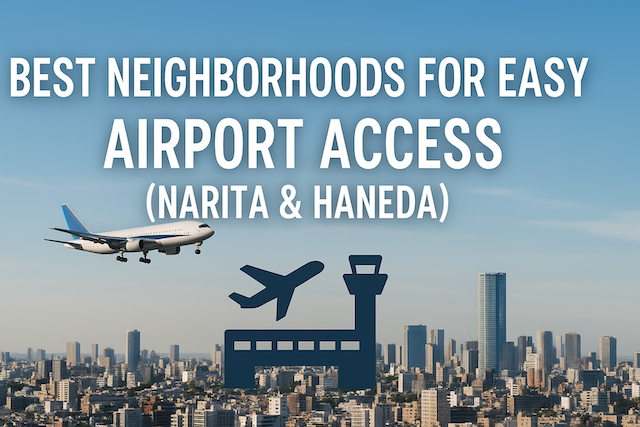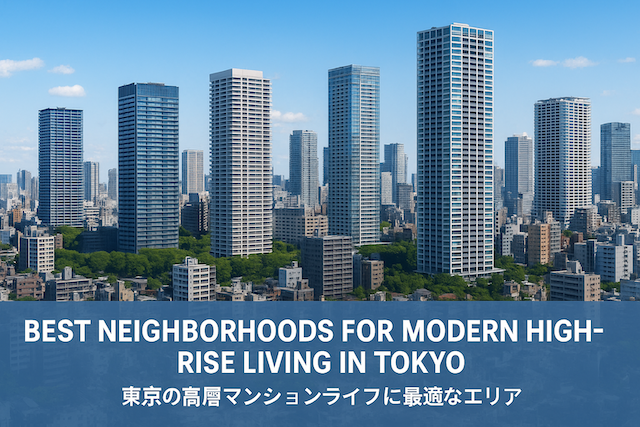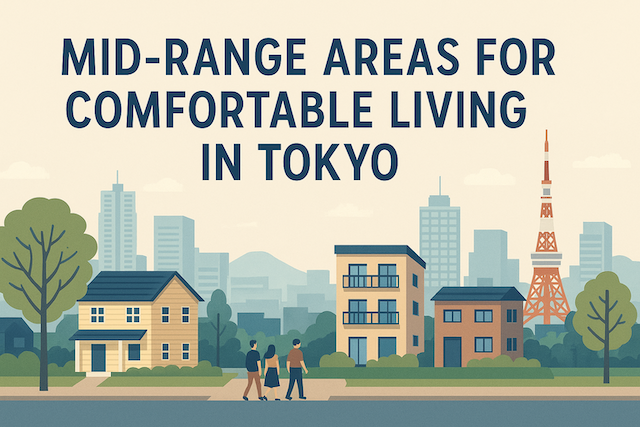Best Value Areas to Rent in Tokyo
Finding a good-value apartment in Tokyo can feel like a puzzle — one that balances price, location, convenience, and comfort. While the Japanese capital is known for its high cost of living, there are still many neighborhoods that offer excellent value for money. Whether you’re a student, young professional, or family, knowing where to look can make a huge difference in your Tokyo experience.
Below, we’ll explore the best value areas to rent in Tokyo, highlighting key neighborhoods that blend affordability, accessibility, and quality of life.
Understanding “Best Value” in Tokyo Rentals
Before naming specific areas, it’s important to define what “best value” means in the Tokyo context. Unlike many other global cities, Tokyo offers a variety of neighborhoods with vastly different personalities and price levels — even within the same train line.
“Best value” typically means:
-
Reasonable rent compared to central Tokyo averages.
-
Easy access to major business districts (Shinjuku, Shibuya, Marunouchi, etc.).
-
Safe and comfortable residential environment.
-
Good amenities, such as supermarkets, restaurants, and parks.
-
Reasonable commute times to popular hubs.
Tokyo’s average rent for a 1LDK (one-bedroom) apartment ranges between ¥120,000–¥160,000 in 2025. However, great-value areas offer similar apartments for ¥80,000–¥110,000, depending on distance from the city center.
1. Nakano – Central Yet Affordable
Nakano is one of Tokyo’s hidden gems when it comes to rental value. Located just west of Shinjuku, it’s only a 7-minute train ride from the city’s busiest district. Despite this proximity, rent here remains notably cheaper.
Why It’s a Great Value
-
Excellent access to Shinjuku, Tokyo, and Shibuya.
-
Vibrant local scene with shopping streets like Nakano Broadway.
-
Plenty of older apartments that are spacious and affordable.
Average Rent (2025)
-
Studio: ¥80,000
-
1LDK: ¥120,000
-
2LDK: ¥160,000
Nakano suits young professionals and students who want to live near central Tokyo without breaking the bank.
2. Koenji – Creative and Affordable
Koenji, located just two stops west of Nakano on the Chuo Line, is known for its bohemian and creative atmosphere. It’s home to many artists, musicians, and students who enjoy a relaxed lifestyle close to the city center.
Why It’s a Great Value
-
Trendy secondhand shops, live music venues, and cafes.
-
A strong sense of community and individuality.
-
Significantly cheaper rent than Shinjuku or Kichijoji.
Average Rent (2025)
-
Studio: ¥75,000
-
1LDK: ¥115,000
Koenji offers a youthful, creative vibe with easy access to central Tokyo — ideal for those who want to balance affordability with culture and individuality.
3. Kitasenju – Affordable East Tokyo Hub
Kitasenju in Adachi Ward is one of the best-kept secrets for affordable urban living. It’s a major transport hub connecting multiple lines, including JR Joban, Tokyo Metro Hibiya, Chiyoda, and Tsukuba Express.
Why It’s a Great Value
-
Great access to central Tokyo and Saitama.
-
Lower living costs compared to west Tokyo.
-
Vibrant local shopping streets and restaurants.
Average Rent (2025)
-
Studio: ¥70,000
-
1LDK: ¥100,000
-
2LDK: ¥130,000
Kitasenju is perfect for commuters and families who want urban convenience with suburban prices.
4. Oimachi – Balanced and Convenient
Oimachi is a strategic location in Shinagawa Ward, giving residents easy access to Shinagawa Station, Haneda Airport, and Yokohama. Despite being close to major business areas, rent remains surprisingly affordable.
Why It’s a Great Value
-
Excellent transport network (JR Keihin-Tohoku, Rinkai, Tokyu lines).
-
A quieter residential vibe compared to central Tokyo.
-
Easy weekend access to Tokyo Bay and Odaiba.
Average Rent (2025)
-
Studio: ¥85,000
-
1LDK: ¥125,000
-
2LDK: ¥160,000
Oimachi is ideal for professionals and expats who travel frequently but still want a comfortable local community.
5. Ikebukuro – Urban Energy with Lower Rent
Ikebukuro is one of Tokyo’s major commercial districts, yet it’s often cheaper than Shinjuku or Shibuya. It offers the urban convenience of a big hub with a mix of affordable apartments — especially just a few minutes outside the main station area.
Why It’s a Great Value
-
Strong train connectivity (JR Yamanote, Seibu Ikebukuro, Tokyo Metro lines).
-
Wide range of rental options, from studios to large family units.
-
Great nightlife, shopping, and entertainment.
Average Rent (2025)
-
Studio: ¥90,000
-
1LDK: ¥130,000
Ikebukuro’s mix of city energy and affordability makes it a strong contender for young professionals and singles.
6. Oji and Akabane – Northern Tokyo Comfort
In northern Tokyo, areas like Oji and Akabane offer great value for renters seeking more space and a quieter lifestyle. These neighborhoods have direct access to central Tokyo via JR and Metro lines.
Why It’s a Great Value
-
Calm, family-friendly environments.
-
Lower rent but convenient access to Ueno and Tokyo.
-
Plenty of parks, riverside walks, and traditional shopping streets.
Average Rent (2025)
-
Studio: ¥70,000
-
1LDK: ¥100,000
-
2LDK: ¥130,000
These areas are great for families or couples who want affordability without giving up Tokyo’s connectivity.
7. Kinshicho and Kameido – Affordable East Tokyo Options
Located in Sumida and Koto Wards, Kinshicho and Kameido are emerging as budget-friendly alternatives to Asakusa and Ueno. They’re close to the Tokyo Skytree and offer a good mix of modern and traditional city life.
Why It’s a Great Value
-
Convenient access to Tokyo Station and Akihabara.
-
Lower rent compared to other east Tokyo hubs.
-
Local shopping centers and family-friendly atmosphere.
Average Rent (2025)
-
Studio: ¥80,000
-
1LDK: ¥115,000
Kinshicho and Kameido are great for students, young professionals, and small families looking for comfort and connection.
8. Meguro and Gotanda – Central Access Without Shibuya Prices
While Meguro is often seen as a high-end area, some parts — especially near Gotanda or south of Meguro River — offer surprisingly affordable rentals.
Why It’s a Great Value
-
Close to Shibuya, Ebisu, and Shinagawa.
-
Excellent transportation and quiet backstreets.
-
Mix of new and older apartments with varying prices.
Average Rent (2025)
-
Studio: ¥95,000
-
1LDK: ¥135,000
Meguro and Gotanda provide central convenience for those who want to be near Tokyo’s trendiest districts but still save on rent.
9. Asagaya and Ogikubo – Peaceful, Affordable, and Well-Connected
Asagaya and Ogikubo, both on the Chuo Line west of Shinjuku, are known for their relaxed charm and affordability.
Why It’s a Great Value
-
Calm residential atmosphere with strong community feel.
-
Excellent access to Shinjuku (10–15 minutes).
-
Affordable compared to nearby Kichijoji.
Average Rent (2025)
-
Studio: ¥80,000
-
1LDK: ¥115,000
These areas are perfect for those who prefer calm living without being too far from the city center.
10. Kamata – Hidden Gem for Budget Renters
Located in Ota Ward near Haneda Airport, Kamata is one of the most underrated areas for renters. It offers a balance between price, convenience, and lifestyle.
Why It’s a Great Value
-
Quick access to Shinagawa and Yokohama.
-
Surrounded by local restaurants, supermarkets, and public baths.
-
Noticeably lower rent than nearby Meguro or Setagaya.
Average Rent (2025)
-
Studio: ¥70,000
-
1LDK: ¥105,000
-
2LDK: ¥140,000
Kamata appeals to budget-conscious renters and frequent travelers who want solid connections and authentic Tokyo living.
Tips for Finding the Best Value Apartment in Tokyo
Even in affordable areas, finding a great deal requires strategy. Here are some key tips:
1. Check Older Buildings
Apartments built before 2000 are often 20–30% cheaper, and many are well-maintained.
2. Look a Few Stations Away
Moving just two or three stops away from major hubs (e.g., from Shinjuku to Nakano) can save thousands of yen per month.
3. Consider Different Lines
The Chuo Line, Keihin-Tohoku Line, and Tobu Tojo Line have many affordable spots with direct access to central Tokyo.
4. Use Japanese Rental Sites
Websites like Suumo, Homes.co.jp, or Chintai list a wide range of apartments with photos and maps — essential for comparison.
5. Don’t Overlook East Tokyo
Eastern wards like Adachi, Sumida, and Katsushika often provide much better value than central or western areas.
Final Thoughts
Tokyo offers a wide variety of living options — from artistic Koenji to family-friendly Oji and bustling Ikebukuro. The key is to find the balance between rent, commute, and lifestyle that fits your needs.
If you’re planning to stay in Tokyo long-term, exploring these best-value areas can save you money while still offering the full Tokyo experience. Whether you choose a cozy studio or a spacious 1LDK, these neighborhoods prove that affordable living in Tokyo is absolutely possible.
FAQs
What does “best value” mean when renting in Tokyo?
“Best value” combines a reasonable monthly rent with strong everyday convenience: short or direct commutes to major hubs (Shinjuku, Shibuya, Tokyo, Shinagawa), safe residential streets, reliable train access, and good local amenities like supermarkets, clinics, parks, and inexpensive dining. It also means stable building quality (even if older), decent layout, and fewer hidden costs such as high key money or excessive management fees.
Which Tokyo neighborhoods are frequently considered great value?
Popular value picks include Nakano, Koenji, Kitasenju, Oimachi, Ikebukuro (and its surrounding sub-areas), Oji, Akabane, Kinshicho, Kameido, Meguro/Gotanda (select pockets), Asagaya, Ogikubo, and Kamata. These offer a blend of affordability, transport options, and everyday livability compared with pricier central wards.
How much should I expect to pay for a studio or 1LDK in value areas?
Ballpark ranges vary by distance from central stations and building age. As a rough guide, studios often fall around ¥70,000–¥95,000 in value clusters, while 1LDK units commonly range from ¥100,000–¥135,000. Proximity to a major hub, recent renovations, and unit size can push prices up or down.
Are older buildings in Tokyo worth considering for better value?
Yes. Well-maintained buildings from the 1980s–1990s (and early 2000s) can be 20–30% cheaper than newer stock. Look for recent renovations (kitchen, bath, flooring), elevator availability, and seismic retrofits. You may trade some insulation or modern amenities for lower rent and larger floor area.
How can I keep commute times short without paying premium rents?
Target neighborhoods that are one to four stops away from a major hub on fast lines (e.g., Chuo, Keihin-Tohoku, Fukutoshin, Hibiya, Chiyoda, Tobu Tojo, Tsukuba Express). Living slightly off the Yamanote loop often slashes rent while keeping door-to-door commutes under 30 minutes.
Is East Tokyo cheaper than West Tokyo?
As a general pattern, many East Tokyo wards (Adachi, Sumida, parts of Koto and Katsushika) offer lower rents than similarly central West Tokyo neighborhoods. However, value exists on both sides: In the west, Chuo Line stops like Nakano, Koenji, Asagaya, and Ogikubo are strong for cost-to-access ratios.
Which lines and stations are best for budget-friendly yet connected living?
Consider the Chuo Line (Koenji, Asagaya, Ogikubo), Keihin-Tohoku Line (Oimachi, Oji), Tobu Tojo Line (northwest access to Ikebukuro), Hibiya/Chiyoda lines (Kitasenju links), and JR Saikyo/Rinkai combos (Gotanda/Oimachi connectivity). Each provides rapid links to employment centers while keeping neighborhoods comparatively affordable.
What fees should I budget for beyond monthly rent?
Upfront costs can include deposit (shikikin, often 0–1 month), key money (reikin, sometimes 0–1 month), agency fee (typically 1 month + tax), lock change, guarantor service, and initial insurance. Monthly extras include management fees, utilities, internet, and possibly bicycle parking. Zero-key-money listings exist but compare total move-in costs.
How do I evaluate a “good deal” when the unit seems inexpensive?
Check: (1) commute time and transfer count, (2) building age vs. renovation quality, (3) natural light and noise, (4) mold or humidity issues, (5) water pressure and hot water system, (6) heater/AC efficiency, (7) total upfront costs, and (8) insurance/guarantor requirements. Visit at different times of day to test noise and street feel.
What’s the best timing to search for value rentals in Tokyo?
Peak turnover is January–March (graduations, job changes), creating more listings but also more competition and higher prices. For calmer bargaining and slower but steady inventory, consider April–June or September–November. If you need a specific area or layout, start 4–8 weeks before move-in.
Do furnished or serviced apartments offer good value?
They trade higher monthly rent for convenience and lower upfront costs (no furniture purchases, minimal setup). For stays under 12 months, the math can favor furnished units. For multi-year horizons, unfurnished in a value area is usually cheaper overall—especially if you buy secondhand furniture.
How can students and first-time renters keep costs down?
Target smaller units near value hubs (Koenji, Kitasenju, Kamata), consider share houses, and look for zero-key-money campaigns. Use major portals (Suumo, Homes, Chintai) with filters for unit size, age, and fees. Touring several options in one day helps you recognize genuine bargains quickly.
Are there safety or lifestyle trade-offs in cheaper neighborhoods?
Tokyo is broadly safe, but micro-locations matter. Compare streets on foot at night, check lighting, station exits, and noise from nightlife or traffic. In busier commercial zones (e.g., near large hubs), expect more nightlife and crowds; quieter residential pockets a few blocks away often balance serenity and access.
What’s a smart strategy for choosing between two similar areas?
Weigh three axes: (1) commute and transfers to your most frequent destinations, (2) lifestyle fit (cafes, parks, supermarkets, gyms, community vibe), and (3) total cost of occupancy (rent + fees + utilities). If all else is close, pick the layout with better light, storage, and ventilation—those daily comforts compound over time.
Any negotiation or application tips for securing a good unit?
Submit a complete application packet quickly (ID, income proof, emergency contact, residency info). Ask about move-in date flexibility, minor rent adjustments on longer leases, or small repairs/cleaning before move-in. If competing, offer a firmer move-in date or accept standard cleaning fees to strengthen your application.
What’s the bottom line for “best value” renting in Tokyo?
Look one or two stations beyond the hottest hubs, prioritize fast lines with minimal transfers, consider renovated older stock, and track total move-in costs—not just monthly rent. Neighborhoods like Nakano, Koenji, Kitasenju, Oimachi, Ikebukuro surrounds, Oji/Akabane, Kinshicho/Kameido, select Meguro/Gotanda pockets, Asagaya/Ogikubo, and Kamata consistently deliver strong price-to-convenience ratios for a wide range of renters.


![Where to Live in Tokyo for Families with Kids [2025–2026 Guide]](https://tokyorelocationguide.com/wp-content/uploads/2025/10/ChatGPT-Image-Oct-17-2025-03_55_59-PM.png)

![Where to Live in Tokyo for Students [2025–2026 Guide]](https://tokyorelocationguide.com/wp-content/uploads/2025/10/ChatGPT-Image-Oct-17-2025-04_32_25-PM.png)


